Last Updated on January 5, 2024 by Greg Gillson
You have asked What are the most common backyard birds in North Carolina? and I am here to help. Using information from the citizen science website eBird, I have gathered identification and location details about the top 31 birds found across the state.
These are the most common backyard birds in North Carolina:
- Northern Cardinal
- Carolina Wren
- Carolina Chickadee
- Tufted Titmouse
- American Crow
- Mourning Dove
- Red-bellied Woodpecker
- Blue Jay
- Eastern Bluebird
- American Robin
- Downy Woodpecker
- Eastern Towhee
- Northern Mockingbird
- American Goldfinch
- House Finch
- Song Sparrow
- White-breasted Nuthatch
- White-throated Sparrow
- Yellow-rumped Warbler
- Chipping Sparrow
- Eastern Phoebe
- Brown Thrasher
- Brown-headed Nuthatch
- Pine Warbler
- European Starling
- Dark-eyed Junco
- Common Grackle
- Indigo Bunting
- Ruby-throated Hummingbird
- Barn Swallow
- Red-eyed Vireo
North Carolina Birds and Birding in North Carolina State
eBird lists over 485 types of birds as occurring in the state of North Carolina.
The most common bird in North Carolina: the most frequently seen bird in the state is Northern Cardinal. It is reported on 60%
of bird watching lists.
The official State Bird of North Carolina is Northern Cardinal.
If you are serious about knowing the birds native to North Carolina, then check out eBird for North Carolina. It has recent sightings and photos, illustrated checklists with weekly abundance bar charts for state, counties, and individual hotspots of the best birding locations.
If you want to know about other people interested in birds in your area, join a local bird group. The American Birding Association maintains a list of bird watching clubs for each state.
North Carolina Bird Identification
(Pictures of backyard birds of North Carolina)
Each species account starts with an image. In the identification section I am using size and shape and bill type before considering the color or patterns on the birds. I find these more reliable when trying to identify an unknown bird. Pay attention to body and tail shape and especially bill shape of birds you see, not just plumage color.
In the section on bird feeders and foods I tell how to attract each species. Not all types of backyard birds will come to feeders. But all backyard birds can be attracted with water. So don’t forget to add a birdbath to your bird feeding station.
Do you live in Eastern North Carolina? Western North Carolina? Central North Carolina? Coastal North Carolina? The Piedmont? Southeastern North Carolina? Or the mountains of North Carolina? To appear in this article, most birds are widely distributed throughout the state and are often year-round residents. However, for those birds that are more localized in place or time, I list the general region and seasonality. Please see the section following these species accounts for the lists of common species by season.
Even if a species is found in a general area, they occur only in the habitat they prefer. So, the exact habitat of your neighborhood is important for the presence of absence of certain kinds of birds.
1. Northern Cardinal (Cardinalis cardinalis)
This is one of the most common and popular backyard birds in the eastern half of the United States.
 |
| Northern Cardinal. Image GeorgeB2 Pixaby |
Range: Northern Cardinals are year-round residents throughout North Carolina.
Identification:
Size: Cardinals are a bit smaller than American Robins, about the same size as Red-winged Blackbirds.
Shape: Plump body with fairly long full tail. Wispy crest.
Bill: Short, heavy, conical, pink.
Color: That bright red color is matched by few other birds. Black face. The female is grayer, but with hints of red in wings and tail, and has a crest, too.
Habitat, range & behavior: Cardinals are year-round residents in shrubby woodland edges.
They are found from the eastern United States to Texas and Arizona south into Mexico.
That large conical bill is made for chewing seeds. Watch them crack open sunflower seeds, spit out the hulls, and pluck the kernel with their tongues!
Food and feeder preference: Black oil sunflower seeds. Many types of seeds, berries, nuts in larger hopper or tray feeders.
You may like my in-depth article on attracting Northern Cardinals.
2. Carolina Wren (Thryothorus ludovicianus)
This is a fairly common backyard bird in the much of the eastern United States.
 |
| Carolina Wren. theSOARnet Pixabay |
Range: Carolina Wrens are year-round residents throughout North Carolina.
Identification:
Size: A smaller bird, between the size of American Goldfinch and House Finch.
Shape: Round body, short neck, flat head, long tail flipped about actively.
Bill: Fairly long, thin, pointed and slightly curved.
Color: Upper parts rusty brown with black bars on the wings and tail. A white eyebrow line and buff under parts.
Habitat, range & behavior: Shrubby thickets and brushy suburban yards.
They are found in the southeastern United States and Yucatan. Northern parts of range expand and contract depending upon harshness of winters.
Males sing throughout the year and are very loud for their size.
Food and feeder preference: Feed mostly on insects and spiders. They will feed on suet.
3. Carolina Chickadee (Poecile carolinensis)
Chickadees are common feeder birds throughout much of North America. This one is common in the southeastern United States.
 |
| Carolina Chickadee. Image GeorgeB2 Pixabay |
Range: Carolina Chickadees are year-round residents throughout North Carolina.
Identification:
Size: This small bid is the size of an American Goldfinch.
Shape: Round body, round head, longer tail.
Bill: Short, straight, stout.
Color: Gray above. Paler below. Black cap, white face, black bib.
Habitat, range & behavior: Lower elevation deciduous forests, wooded residential areas.
This chickadee is a resident in the southeastern US.
Chickadees cannot chew as sparrows do, so they take one large sunflower seed at a time from your feeder and fly off to a branch to pound it open with their stout bills.
Food and feeder preference: Most of their diet is insects, also seeds. They will eat black oil sunflower seeds from hopper feeders.
4. Tufted Titmouse (Baeolophus bicolor)
Related to chickadees, they lack the black bib, but have a crest instead.
 |
| Tufted Titmouse Image anne773 Pixabay |
Range: Tufted Titmice are year-round residents throughout North Carolina.
Identification:
Size: A small bird, but a large titmouse, this species is larger than chickadees, about the size of a junco or House Finch.
Shape: Rounded body, long full tail, big head, long legs.
Bill: Short and stout, compressed (taller than wide), black.
Color: Dark blue-gray above, pale below. Black feathers around eye accentuates its size.
Habitat, range & behavior: Lives in deciduous forests with heavy canopy, parks.
Found in eastern and southeastern United States is expanding its range north and west.
Backyard bird feeders might be helping this species expand its range northward.
Food and feeder preference: Insects and seeds. At your hopper or tray feeder they like black oil sunflower seeds and suet.
5. American Crow (Corvus brachyrhynchos)
This larger all-black bird is common in cities and country. Its cawing call is familiar to most people.
 |
| American Crow. Photo by Greg Gillson |
Range: American Crows are year-round residents throughout North Carolina.
Identification: This is a key species for comparing with an unknown bird.
Size: About 17-1/2 inches long from bill tip to tail tip, though there is much size variation throughout its range. Larger than blackbirds and grackles. Smaller than ravens.
Shape: Thick neck, large head, rather short square-ended tail. Longer legs. In flight has rounded wing tips with each primary feather separated from others forming “fingers.”
Bill: As long as head, thick, black.
Color: Glossy black throughout.
Habitat, range & behavior: They prefer open areas with trees, fields, farms, cities.
They are common across most of the United States lower-48, except in the desert southwest. They move into southern Canada in summer.
They gather in evening communal roosts in large flocks that may number into the thousands and then move out at dawn into the surrounding area.
Food and feeder preference: Omnivorous, they feed on large insects, grain, small mammals, carrion. You probably don’t want these large entirely black birds in your backyard feeders. So don’t feed table scraps to birds.
6. Mourning Dove (Zenaida macroura)
Mourning Doves are the most widespread and most frequent backyard bird in the Lower 48 states of the United States.
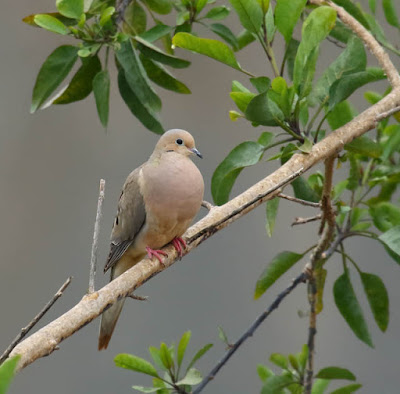 |
| Mourning Dove. Greg Gillson |
Range: Mourning Doves are year-round residents throughout North Carolina.
Identification: This is a key species for comparing with an unknown bird.
Size: About 12 inches long from bill tip to tail tip. About same size as Northern Flicker. Larger than American Robin. Slightly smaller than domestic city pigeon.
Shape: Very plump with a small round head. Tail is long and pointed. Legs are short.
Bill: Small and rather slender.
Color: Pale brown-pink body, darker wings and tail. White edges on side of tail.
Habitat, range & behavior: Semi-open areas such as urban areas, farmlands, woods.
It is a resident across the lower-48 states and Mexico, with some movement out of northern areas in winter.
Often seen perched on wires, fences. Their mournful cooing is a familiar spring birdsong.
Food and feeder preference: Mourning Doves eat seeds almost exclusively. Attract with black oil sunflower seeds on a large sturdy tray feeder or on the ground.
7. Red-bellied Woodpecker (Melanerpes carolinus)
This is one of the most common species in the eastern half of the United States.
 |
| Red-bellied Woodpecker. skeeze Pixabay |
Range: Red-bellied Woodpeckers are year-round residents throughout North Carolina.
Identification:
Size: Fairly large for a backyard bird. Between a Starling and American Robin in size. Smaller than a Northern Flicker.
Shape: Stout with large head and short tail. Clings to tree trunk on strong short legs propped up with short stiff tail.
Bill: Long, chisel shaped.
Color: Pale gray body, many thin black-and-white bars across back and wings. Red nape, extending forward on crown on male.
Habitat, range & behavior: These birds are found in many woodland types, including oak, hickory and pine.
They are found from the eastern slope of the Rocky Mountains in the lower-48 states from Texas to extreme southern Canada, and eastward from Florida northward just to the southern edge of the New England states.
In typical woodpecker fashion, it hitches up the tree trunk and larger branches.
Food and feeder preference: This species eats insects and nuts. They may eat peanuts from a tray feeder and eat from a suet block.
8. Blue Jay (Cyanocitta cristata)
A common and well-known bird in the eastern half of the United States.
 |
| Blue Jay. Image skeeze Pixabay |
Range: Blue Jays are year-round residents throughout North Carolina.
Identification:
Size: About that of American Robin.
Shape: Fluffy, large crested head, ample tail. Large strong legs.
Bill: Black, long and stout.
Color: Blue above, white below. Black neck collar. White patches in wing.
Habitat, range & behavior: Woodlands and towns.
Found in the eastern half of the United States. In summer into southern Canada.
Bold and brash. May bully smaller birds. Jays gulp lots of seeds or other food at once, storing it in their crop. Then they fly off and bury food items in a hidden cache.
Food and feeder preference: Omnivorous. They can quickly empty your feeder! Because they are also aggressive toward other feeder birds, some people put mesh cages around smaller bird feeders. Small birds can go through, squirrels and larger “pest” birds are prevented entry. Some people feed jays peanuts, perhaps away from the seed feeders.
9. Eastern Bluebird (Sialia sialis)
A beloved bird of open fields with trees and fence lines for perching.
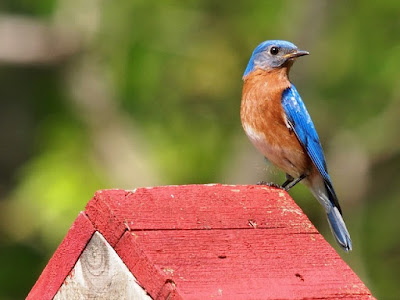 |
| Eastern Bluebird. Image skeeze Pixabay |
Range: Eastern Bluebirds are year-round residents throughout North Carolina.
Identification:
Size: Larger than House Finches. Much smaller than starlings. About length of White-crowned Sparrow but differently proportioned.
Shape: Chunky, large head, short tail.
Bill: Straight, fairly slender, curved at tip.
Color: Males are brilliant blue above (including wings and tail), rusty orange below with white belly and under tail. Females are often much paler, almost grayish.
Habitat, range & behavior: Found in pasture, fields, golf courses, open woodland edges.
They are resident in most of eastern US, highlands of Middle America. In summer reach northernmost eastern US and southernmost eastern Canada, withdrawing somewhat in winter.
They readily use nest boxes, but the entrance hole must be smaller than the head of a starling, and without a perch.
Food and feeder preference: They eat flying insects primarily, but also other invertebrates and berries. They will eat mealworms at your feeder and frequent birdbaths.
10. American Robin (Turdus migratorius)
This familiar bird is a resident in the northern half of the United States and a winter visitor in the southern half.
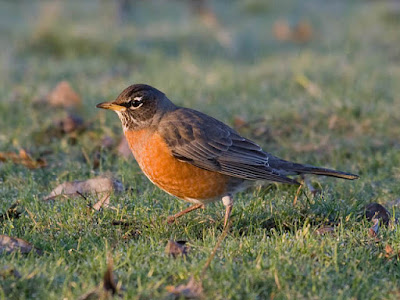 |
| American Robin. Greg Gillson |
Range: American Robins are year-round residents throughout North Carolina.
Identification: This is a key species for comparing with an unknown bird.
Size: 10 inches long from bill tip to tail tip. About the same size as a Blue Jay or one of the Scrub-Jays. Larger than Red-winged Blackbird. Smaller than a Mourning Dove.
Shape: Very plump with a fairly long tail.
Bill: Straight and fairly slender, curved at the tip.
Color: Gray-brown upperparts, rusty orange breast.
Habitat, range & behavior: Open woodlands, farmlands, urban parks and lawns.
Migratory, breed north across Alaska and Canada. Resident in most of the United States (lower 48). Winter in the United States, Mexico, to central America.
Hop on your lawn turning head this way and that looking for food. Their caroling song is one of the early signs of spring in the north.
Food and feeder preference: Worms and other invertebrates in the lawn. May eat fruit from a tray feeder or the ground. Eat small berries from trees and bushes.
11. Downy Woodpecker (Dryobates pubescens)
This tiny woodpecker is found across the United States.
 |
| Downy Woodpecker. Greg Gillson |
Range: Downy Woodpeckers are year-round residents throughout North Carolina.
Identification:
Size: Bigger than a junco or House Finch. Smaller than a Red-winged Blackbird. About the same size as a White-crowned Sparrow, but with a much shorter tail.
Shape: Stocky with large head and short stiff tail.
Bill: Short, chisel shaped.
Color: Black-and-white striped head. Black wings with white spots. Solid white back. White under parts. Black tail with white outer tail feathers with black bars or spots. Male with small red spot at back of head.
Habitat, range & behavior: Found in small deciduous trees, willows, and even weed stocks such as teasel, especially near water.
Ranges coast-to-coast across all but northernmost parts of Canada and Alaska south to the southern US. Absent in the desert southwest.
Interestingly, I learned today that the males may more often be found in smaller plants and twigs, while females are more likely on tree trunks.
Food and feeder preference: Insects, fruits, and seeds. Gleans arthropods from the bark of trees. Attract with suet feeder. Will also eat black oil sunflower seeds.
12. Eastern Towhee (Pipilo erythrophthalmus)
This big ground-dwelling sparrow was recently split from Rufous-sided Towhee, creating the Eastern Towhee in the East and the Spotted Towhee in the West.
 |
| Eastern Towhee. Image skeeze Pixabay |
Range: Eastern Towhees are year-round residents throughout most of North Carolina, summer residents only in western mountains.
Identification:
Size: About the length of a White-crowned Sparrow; larger than a House Finch, smaller than a Starling or Red-winged blackbird.
Shape: Rather bulky compared to other sparrows, large head, long rounded tail.
Bill: Short, conical.
Color: Blackish above, rusty sides, white belly. Females paler and browner. White tail corners. White wing patch.
Habitat, range & behavior: They live in brushy areas, hedges, woodland edges.
Found in the eastern United States. Resident in SE US, in summer the move north to the border with Canada.
They rummage around in leaf litter under thick bushes, kicking and scratching the ground with both feet at once.
Food and feeder preference: Eat mostly insects and invertebrates in summer, adding berries, fruits, and especially seeds in winter. At your feeder they will visit a hopper feeder but may prefer a wide platform feeder. They may more often feed on the ground under the feeder.
13. Northern Mockingbird (Mimus polyglottos)
This bird sings from exposed perches most of the year and often through the night. They have an unending supply of their own unique short phrases that they repeat about 3 times each, but frequently intersperse songs of other birds.
 |
| Northern Mockingbird. Greg Gillson |
Range: Northern Mockingbirds are year-round residents throughout North Carolina.
Identification:
Size: The length of an American Robin.
Shape: Slender and long tailed. Long legs.
Bill: Medium length, slender, slightly curved.
Color: Gray, darker above, with white patches in wing and tail.
Habitat, range & behavior: They prefer edge habitat with scattered trees and bushes, parks and residential areas.
They are found in eastern and southern parts of the US, West Indies, and south into Mexico. In summer birds are found a bit farther north.
They boldly defend their nests from other birds, cats, and intruders.
Food and feeder preference: Eats insects, berries, and fruit. You may attract mockingbirds to your feeder with grapes, raisins, apple slices. They will come to a suet block. They readily use a bird bath.
14. American Goldfinch (Spinus tristis)
A beautiful tiny finch familiar to many in its bright yellow summer plumage. Colloquially called a “wild canary.”
 |
| American Goldfinch. Greg Gillson |
Range: American Goldfinches are year-round residents throughout North Carolina.
Identification: This is a key species for comparing with an unknown bird.
Size: Very small at about 5 inches from bill tip to tail tip. Similar in size to a chickadee. Larger than hummingbirds. Smaller than juncos and House Finches.
Shape: Tiny, somewhat plump with larger head and short tail.
Bill: Short, conical, pink.
Color: Males in summer are bright lemon yellow with black forehead and black wings and tail with white bars. White under tail coverts. Females are dull olive, wings and tail browner. Winter birds are pale grayish-yellow with tan and brown wings and tail.
Habitat, range & behavior: This species is found in weedy fields and similar clearings with thistles and similar plants.
They are found coast-to-coast throughout the year across most of the middle lower-48 states. In summer move north to the Canada border. In the winter found south to the Mexico border.
The flight is highly undulating, rising and falling as they flap in short bursts. Besides a long, sweet lilting song, they call in flight a lilting 4-part: “potato chip!”
Food and feeder preference: Feeds on weed seeds, thistle seed. May eat black oil sunflower seeds from tube feeder. Love Nyjer seed in a feeder called a “thistle sock.”
You may like my in-depth article on attracting American Goldfinches.
15. House Finch (Haemorhous mexicanus)
Originally a bird of the West, now found across most of the US. There are other red finches, but these are the ones most likely in residential areas.
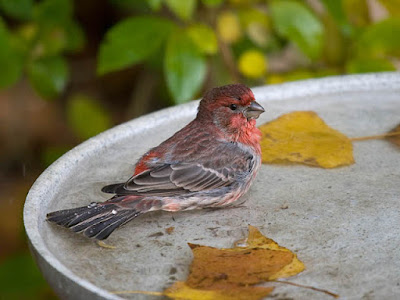 |
| House Finch. Greg Gillson |
Range in North Carolina: House Finches are year-round residents throughout North Carolina.
Identification: This is a key species for comparing with an unknown bird.
Size: About 6 inches from bill tip to tail tip. Larger than goldfinches and chickadees. Smaller than a White-crowned Sparrows or Spotted/Eastern towhees.
Shape: Medium build with a medium-long notched tail. Round head.
Bill: Short, conical.
Color: Brown and gray above with streaks on the sides of the pale underparts. Males with red (sometimes orange or rarely yellow) crown, chest, rump.
Habitat, range & behavior: You’ll find small flocks on wires, in short treetops and in bushes. Originally deserts and grasslands. Rural areas and towns are where they’re now most common.
Formerly found in the western United States and Mexico. Then introduced into the northeastern United States, but now found in nearly all of the lower-48 states and extreme southern Canada. Rare in plains states (Dakotas to Texas) and southern Florida.
House Finches are not territorial, but males sing throughout the year–a lively, wiry song ending in a couple of buzzy notes.
Food and feeder preference: They love sunflower seeds and tube feeders. May eat from thistle socks.
You may like my in-depth article on attracting House Finches.
16. Song Sparrow (Melospiza melodia)
A common bird, but variable, and similar to many other streaked brown sparrows.
 |
| Song Sparrow. Greg Gillson |
Range: Song Sparrows are year-round residents in western North Carolina, winter visitors only in eastern North Carolina.
Identification:
Size: A smaller bird, similar in size to House Finch and juncos. Larger than chickadees and goldfinches. Smaller than White-crowned Sparrows or Spotted/Eastern towhees.
Shape: Plump with round head, long rounded tail.
Bill: Short, conical.
Color: Highly variable in darkness and color saturation across its range (dark rusty to pale gray). Generally gray-brown above with dark brown streaking on back. Complicated head pattern. Streaking on sides and breast converge into dense central breast spot.
Habitat, range & behavior: Thickets, especially near water. Backyard shrubbery.
Resident in western United States, western Canada, coastal southern Alaska, northeastern US. In summer also moves into mid-Canada and northern half of US. In the winter found in most of the US lower-48. Also, a population in central Mexico.
Forages on ground, never far from low cover to which they fly if startled.
Food and feeder preference: They feed on seeds and insects near the ground. Will visit hopper and tray feeders for mixed bird seed.
17. White-breasted Nuthatch (Sitta carolinensis)
A favorite feeder bird for many for its active antics and fearlessness. Though a small bird it is the largest nuthatch in North America.
 |
| White-breasted Nuthatch. Greg Gillson |
Range: White-breasted Nuthatches are year-round residents throughout North Carolina.
Identification:
Size: About chickadee-sized in length. Smaller than a junco or House Finch.
Shape: Appears large-headed, neckless, very short tailed. Short legs.
Bill: Nearly as long as head, straight, thin.
Color: Blue-gray above, white below. Black cap, wing tips, tail. Rusty feathers under tail.
Habitat, range & behavior: Common in oak and oak-pine woodlands, wooded towns.
Found across the United States, southern Canada, mountains of central Mexico. Absent from treeless grasslands, deserts in the west.
Crawls over tree branches and head-first down tree trunks searching for insects.
Food and feeder preference: Insects, seeds, acorns and other nuts. Love black oil sunflower seeds feeding on hopper and tray feeders. Suet blocks.
18. White-throated Sparrow (Zonotrichia albicollis)
A fairly common bird of northern forests that visits backyards across much of the US.
 |
| White-throated Sparrow. Greg Gillson |
Range: White-throated Sparrows are winter visitors throughout North Carolina.
Identification:
Size: Similar in size to White-crowned Sparrow. Bigger than a House Finch; smaller than a starling.
Shape: Longer body. Round head on short neck. Long tail with notched tip.
Bill: Short. conical.
Color: Striped tan and brown above, pale gray below. White-striped form with black and white head stripes. Tan-striped form with tan and brown striped head. First year birds are similar to tan-stiped adults, but streakier overall. Yellow spot between eyebrow and bill. White throat strongly offset from gray breast and face.
Habitat, range & behavior: Found in forests, brush, and open woodland edges.
Breeds across Canada and northernmost Eastern United States. Winters in the eastern US, southern central US, and rare but regular along the West Coast.
Found in small flocks on ground near brush into which they can flee. Kick up leaves to search under for food.
Food and feeder preference: Eat seeds and berries in winter, more insects and fruit in summer. In your feeder will eat mixed seeds on a platform feeder and on the ground.
19. Yellow-rumped Warbler (Setophaga coronata)
An abundant winter visitor in southern US to treetops and weedy areas.
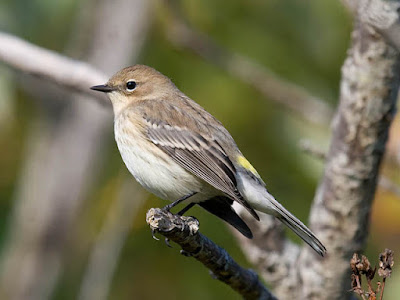 |
| Yellow-rumped Warbler. Greg Gillson |
Range: Yellow-rumped Warblers are winter visitors throughout North Carolina.
Identification:
Size: Small, they are a bit larger than chickadees and goldfinches. They are smaller than House Finches and juncos.
Shape: Plump and neckless with a shorter tail.
Bill: Short, slender, straight, pointed.
Color: Breeding plumage in spring is blue-gray on the upper parts, black sides and chest, yellow rump, yellow on sides. Two forms: western form with yellow throat and large white wing patch; eastern and northern form with white throat and two white wing bars. In winter plumage both forms are gray-brown above, pale cream below. Yellow rump and white tail corners in flight.
Habitat, range & behavior: In breeding season mostly in coniferous or mixed forests, in mountains in west. In winter open areas with fruiting shrubs and scattered trees.
Breed across Canada and Alaska and in conifer forests in the west. Winter along both coasts and the southern states through Middle America. There are also non-migratory forms in Mexico and Guatemala.
They tend to forage in outer branches about half way up the tree.
Food and feeder preference: Mainly insects in the summer, they switch to waxy berries and fruit in winter. They are thus able to winter farther north than other warblers. They are attracted to suet feeders.
20. Chipping Sparrow (Spizella passerina)
Chipping Sparrows are a widespread species adapted to human disturbance. They are rather tame. They are frequently found in cemeteries with large trees.
 |
| Chipping Sparrow. Greg Gillson. |
Range: Chipping Sparrows are summer residents throughout North Carolina.
Identification:
Size: These are small sparrows, bigger than goldfinches or chickadees, but smaller than House Finches or Song Sparrows.
Shape: Plump and fairly long tailed.
Bill: Short and conical.
Color: Striped brown and dark brown above. Grayish under parts. Black line through eye. Crown streaked in winter but in summer becomes solid chestnut. Two white wing bars.
Habitat, range & behavior: Grassy open conifer woodlands with some shrubs, parks, orchards.
Breeds from Alaska, across Canada and south into highlands of Middle America. In winter retreats from northern areas to southern United States and northern Mexico.
In summer solitary or in pairs. In winter they forage in flocks of up to 50 birds.
Food and feeder preference: Weed seeds, supplemented with insects in summer. They may eat black oil sunflower seeds in your feeder, but more likely will feed on mixed seeds on the ground under the feeder.
21. Eastern Phoebe (Sayornis phoebe)
This plain bird is common in backyards in the East.
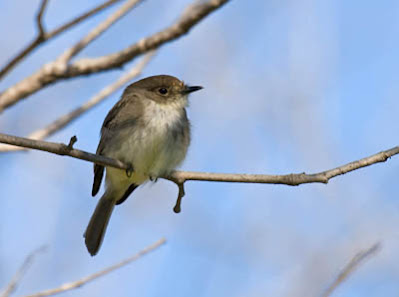 |
| Eastern Phoebe. Greg Gillson. |
Range: Eastern Phoebes are year-round residents throughout North Carolina.
Identification:
Size: About the size of bluebirds. Larger than House Sparrows.
Shape: Rather stout, with long wings, medium-length tail. Pointed but flat bill. Upright posture.
Bill: Black, pointed, wide and flat.
Color: Brownish-gray above, slightly yellow-olive on sides. White under tail coverts. No eye ring or wing bars help distinguish them from some other flycatchers.
Habitat, range & behavior: Found in woodlands, suburbs, farms. Frequently nest in rafters, under eaves, porches.
They are summer residents east of the Rocky Mountains from Canada southward. Year-round residents through the interior of the Southeast, to Texas. Winter visitor to Gulf Coast and southern Atlantic.
Phoebes pump their tail down. They also frequently spread their tails.
Food and feeder preference: They eat flying insects that they catch on the wing. Not a feeder visitor.
22. Brown Thrasher (Toxostoma rufum)
These birds are accomplished singers, with over 1100 different songs recorded!
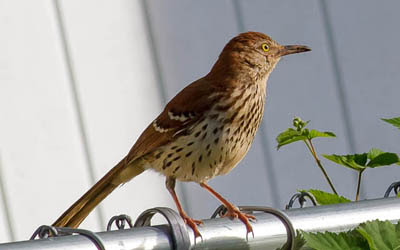 |
| Brown Thrasher. Linda Jones. CC0. |
Range: Brown Thrashers are year-round residents throughout North Carolina.
Identification:
Size: Longer than a robin, smaller than a flicker.
Shape: Pot-bellied. Long tail with rounded tip. Large head.
Bill: Long and thin, slightly curved down.
Color: Rusty above. Gray face. Heavy rusty streaks below on cream-colored under parts. Two white wing bars.
Habitat, range & behavior: These birds live in woodland edges and hedges.
They are year-round residents in the Southeast. In summer they also breed northward, east of the Rocky Mountains to southern Canada.
You may find them feeding on the edge of lawns with a very horizontal posture. They may mimic other bird songs and calls.
Food and feeder preference: They primarily eat insects and invertebrates. But they will also come to platform feeders for sunflower seeds, nuts, suet, berries.
23. Brown-headed Nuthatch (Sitta pusilla)
These birds are restricted to pine forests in the Southeast.
 |
| Brown-headed Nuthatch. mlmclaren from Pixabay. |
Range: Brown-headed Nuthatches are year-round residents throughout most of North Carolina, absent in extreme western North Carolina.
Identification:
Size: Very small bird. Smaller than American Goldfinch.
Shape: Plump with large head on short neck. Tiny tail. Big feet.
Bill: short and sharp pointed.
Color: Gray above with darker wings. Brown crown. White throat and under parts.
Habitat, range & behavior: Found in open stands of old pure pine.
They are residents in the southeastern United States.
They crawl over bark of trunk and branches–even upside down.
Food and feeder preference: They eat insects and may come to feeders for suet or small seeds.
24. Pine Warbler (Setophaga pinus)
These well-named birds are residents in the Southeast and early spring migrants in the East.
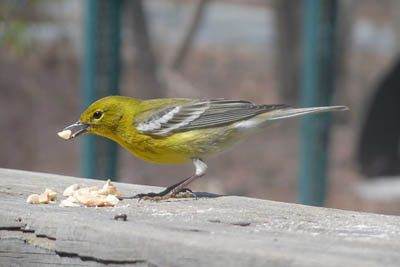 |
| Pine Warbler. Nikolaus Schultz from Pixabay. |
Range: Pine Warblers are year-round residents throughout most of North Carolina, summer residents only in the mountains of western North Carolina.
Identification:
Size: A smaller bird, a little longer than a goldfinch.
Shape: These birds have a typical warbler shape, compact with a longer tail.
Bill: Fairly long, sharply pointed.
Color: These are kind of a dull yellowish-green on the head and back. The breast is more yellowish, especially in males. There are some dull greenish streaks on the breast. The wings and tail are rather gray, with two bold white wing bars. The under tail coverts and lower belly is white.
Habitat, range & behavior: Almost always found in pines.
Year-round resident in the Southeast; summer resident in the eastern United States northward to southernmost Canada.
Tend to stay high in the pines, where often detected by their dry trilled song.
Food and feeder preference: Usually insects. However, these are on of the few warblers to eat seeds. They will feed on millet and sunflower seeds at hopper feeders. Also eat suet.
25. European Starling (Sturnus vulgaris)
Introduced to North America in the late 1800’s, they crossed the continent, often to the detriment of native cavity-nesting birds. The prime example of an invasive species.
 |
| European Starling. Greg Gillson. |
Range: European Starlings are year-round residents throughout North Carolina.
Identification:
Size: About the size of a Red-winged Blackbird. Smaller than an American Robin. Larger than a White-crowned Sparrow or Spotted/Eastern towhee.
Shape: Stocky with large head, short square-ended tail. Longer legs.
Bill: As long as head. Sharp pointed. Yellow in spring, otherwise dark.
Color: They are grayish brown much of the year, with glossy iridescence and white spotting during the spring.
Habitat, range & behavior: Lowland birds that need trees large enough for nest cavities but plenty of open area for feeding. They are most abundant in urban and suburban areas where they find food and artificial nest cavities.
Resident from coast-to-coast from southern Canada to northern Mexico. In summer north across Canada and Alaska. Native range is Europe to Pakistan, north Africa.
Often viewed as a pest, starlings often bully other backyard birds, taking over bird feeders, and stealing nest cavities from smaller native birds.
In winter they can form into flocks of tens of thousands.
Food and feeder preference: European Starlings eat primarily insects when available, often feeding on the ground. Discourage them from your backyard hopper and tray feeders by never feeding birds table scraps (including bread or meat). They have weak feet and do not perch well on tube feeders. A cage mesh around smaller hopper feeders may keep them out.
26. Dark-eyed Junco (Junco hyemalis)
Colloquially called “snowbirds,” they often arrive in backyards in winter from nearby mountain forests or more northern climes.
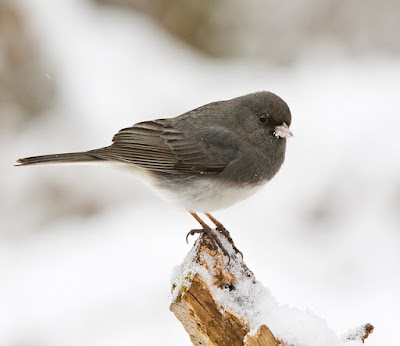 |
| Dark-eyed Junco. skeeze from Pixabay |
Range: Dark-eyed Juncos are winter visitors throughout North Carolina, year-round residents in western mountains.
Identification:
Size: Small birds about the size of a House Finch.
Shape: Round body, short neck, round head, fairly long square-ended tail.
Bill: Short, pointed, conical, pink.
Color: Eastern birds are a darker all-gray with white belly. Western birds have jet black hood over their head, brown back, and pink sides.
Habitat, range & behavior: Breed in coniferous forests. Winters widely. Avoids heavy brush, preferring widely spaced bushes.
Breeds across most of Canada, Alaska, and the western half of the United States. Winters from southern Canada and all of the lower 48-states to extreme northern Mexico.
Spend much of their time hopping and feeding on the ground.
Food and feeder preference: Eats mostly seeds, also insects in summer. Readily feed at backyard feeders on mixed seeds on hopper or tray feeders and ground.
You may like my in-depth article on attracting Dark-eyed Juncos.
27. Common Grackle (Quiscalus quiscula)
Sometimes considered a pest to crops, grackles are longer and lankier than very similar blackbirds.
 |
| Common Grackle. GeorgiaLens from Pixabay |
Range: Common Grackles are year-round residents throughout North Carolina.
Identification:
Size: Larger than Red-winged Blackbirds, they are near the length of Mourning Doves.
Shape: Long, with long full keel-shaped tail, long legs, flat crown.
Bill: Longer than head, pointed, but stouter than other blackbirds.
Color: Glossy black with hint of bronze or green on head (depending upon population). Yellow eye.
Habitat, range & behavior: They are found in agricultural areas, woodland edges, city parks and lawns.
Resident in the southeastern United States. In summer they migrate northward and west to the central United States and Canada.
They monopolize feeders and are bullies toward other birds.
Food and feeder preference: Grain, corn, acorns, small aquatic fish and amphibians. To discourage them, use tube feeders, rather than hopper or tray feeders. Don’t over-feed, keep spilled seed picked up.
28. Indigo Bunting (Passerina cyanea)
Don’t mistake Indigo Buntings for the larger Blue Grosbeak. As the name suggests, the grosbeak has a much larger and thicker bill, along with rusty wing bars, lacking in Indigo Buntings.
 |
| Indigo Bunting by Dan Pancamo |
Range: Indigo Buntings are summer residents throughout North Carolina.
Identification:
Size: These birds are a bit smaller than a House Sparrow.
Shape: Plump. Large round head. Medium short tail.
Bill: Large and conical.
Color: Males are deep blue. Females are pale gray-brown with diffuse streaks below.
Habitat, range & behavior: Open woodlands and clearings. Country farm roads.
They are found in the East and parts of the Southwest, north to southern Canada.
Sing from the tallest tip of tree or telephone lines, a cheerful paired bouncy song very similar to American Goldfinch. In fact, they are sometimes called “blue goldfinches” because of this!
Food and feeder preference: These birds will eat seeds from hopper feeders, perhaps more so in the late spring when they first arrive during migration.
29. Ruby-throated Hummingbird (Archilochus colubris)
This is the only hummingbird that breeds in the eastern half of the United States and Canada.
 |
|
Ruby-throated Hummingbird by jeffreyw. |
Range: Ruby-throated Hummingbirds are summer residents throughout North Carolina.
Identification:
Size: A tiny bird, much smaller than any other in the eastern US, except perhaps some other rare hummingbird.
Shape: The small body is chunky, with a big head, and short tail.
Bill: Very long and tubular, slightly down curved.
Color: Metallic green above, white below with scattered green or gray feathers. Male with glimmering ruby red throat that is black unless it refracts sunlight at just the right angle.
Habitat, range & behavior: They find flowers at forest edges and flower gardens.
They summer in the eastern US and southern Canada, east of the Rocky Mountains. Some winter in from the coast of the Carolinas to Florida and along the Gulf Coast.
Darting flight on a blur of wings that buzz when they flap so fast! They feed by poking their long bill into flowers.
Food and feeder preference: They drink flower nectar from tubular flowers using their long brush-tipped tongue. They also feed on spiders and small flying insects. They are readily attracted to hummingbird feeders filled with sugar water.
30. Barn Swallow (Hirundo rustica)
These swallows are widely distributed throughout the world, primarily breeding in the northern hemisphere, and wintering in the mid-latitudes and southern hemisphere.
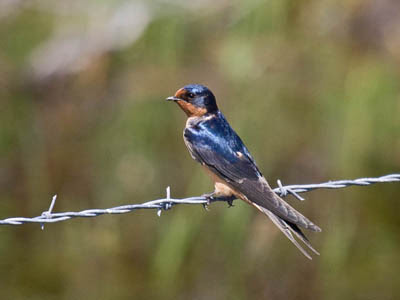 |
| Barn Swallow. Greg Gillson. |
Range: Barn Swallows are summer residents throughout North Carolina.
Identification:
Size: About the size of a House Finch but with a much longer tail.
Shape: Stocky, short necked but with long body and tail. Tail is forked, with very long outer tail feathers. Wings pointed.
Bill: Short, wide.
Color: Glossy dark purplish-blue above. Pinkish-orange below.
Habitat, range & behavior: Barn Swallows live in open country, frequently near humans. Farmlands. Nest in barns, under small bridges.
In North America breed from Mexico to northern Canada and Alaska, wintering from southern Mexico throughout most of South America.
Frequently seen swooping low over the ground hunting flying insects. Perch on wires, fences. Voice is twitters and chirps with grating sounds.
Food and feeder preference: Eat flying insects on the wing and are not attracted to backyard feeders.
31. Red-eyed Vireo (Vireo olivaceus)
This is one of the most common songbirds in eastern woodlands.
 |
| Red-eyed Vireo. Greg Gillson. |
Range: Red-eyed Vireos are summer residents throughout North Carolina.
Size: Small, about the size of an American Goldfinch. Smaller than a House Finch.
Shape: Long and slim, but with rather short tail. Big-looking head.
Bill: Longer, stout. Pointed but small hook on the end, as all vireos.
Color: They are olive-green above, white or with a hint of yellow below. Gray crown, bordered by black line, white eyebrow, and another thin black line through red eye.
Habitat, range & behavior: Tall deciduous trees, such as cottonwoods.
Breed across Canada, the Rocky Mountains and most of the East. Absent from much of the West and Southwest.
As with many vireos, they sing persistently through the summer and through the heat of the day, not just primarily during spring and at dawn as many other songbirds.
Food and feeder preference: They eat insects and will not come to feeders.
Common Birds in North Carolina (Lists of most common feeder birds and most common backyard birds by season)
To determine how common each species is I used the data from actual bird sightings from the citizen science program eBird. Birds are listed by frequency. That is, how often the species is recorded on checklists submitted to eBird (a percentage).
When choosing the birds to include in this article I leaned strongly to birds that are present throughout the year in good numbers. Thus, many of the common birds are year-round residents. This means that they live in the same location all year. They raise their young in your neighborhood. They don’t migrate. Or if the species does migrate, the ones living in your area don’t. If this is the case, some migrants may move into your area during certain times of year, adding to the same species that are in your yard full time.
Some migrant birds visit your yard during the “summer.” Often, they arrive in spring and remain until late fall. They nest and raise their young in your neighborhood. These are the summer residents.
Other migrant birds visit your backyard during the “winter.” Some of these winter visitors may arrive in July and remain into April. Others may only be found in the cold of December or January. They key here is that they nest and raise their young somewhere else. They only visit your yard in the non-breeding season.
Migration is an amazing spectacle. There will be birds that fly through your region in spring or fall (or both). They may visit your backyard only a few days or weeks a year. They aren’t regular enough, or stay long enough, to be included in this article. But the number of briefly visiting migrant birds could double the number of species presented here. You may see them over time. Consult checklists in eBird for your county to see what is possible.
I have generally excluded common waterfowl, birds of prey, shorebirds, seabirds, and others that aren’t usually found in residential areas. But they may certainly fly over or be seen regularly if your home is on a shoreline, for instance.
Most common backyard birds in North Carolina throughout the year
The following list is the backyard birds that are, on average, most common throughout the entire year. The list is ordered by most common based on the frequency of how often each species is recorded on checklists submitted to eBird.
The most common backyard birds throughout the year in the state of North Carolina, in order, are these:
- Northern Cardinal (60% frequency)
- Carolina Wren (54%)
- Carolina Chickadee (53%)
- Tufted Titmouse (47%)
- American Crow (45%)
- Mourning Dove (41%)
- Red-bellied Woodpecker (39%)
- Blue Jay (38%)
- Eastern Bluebird (34%)
- American Robin (33%)
- Downy Woodpecker (32%)
- Eastern Towhee (32%)
- Northern Mockingbird (30%)
- American Goldfinch (30%)
- House Finch (27%)
- Song Sparrow (25%)
- White-breasted Nuthatch (23%)
- White-throated Sparrow (21%)
- Yellow-rumped Warbler (19%)
- Chipping Sparrow (19%)
- Eastern Phoebe (18%)
- Brown Thrasher (17%)
- Brown-headed Nuthatch (17%)
- Pine Warbler (17%)
- European Starling (16%)
- Dark-eyed Junco (16%)
- Common Grackle (15%)
Most common backyard birds in North Carolina in winter
- Northern Cardinal (57% frequency)
- Carolina Chickadee (55%)
- Carolina Wren (51%)
- Tufted Titmouse (48%)
- American Crow (41%)
- Red-bellied Woodpecker (39%)
- Mourning Dove (37%)
- White-throated Sparrow (36%)
- Eastern Bluebird (35%)
- Downy Woodpecker (35%)
- Blue Jay (32%)
- Song Sparrow (32%)
- Dark-eyed Junco (31%)
- American Robin (30%)
- Yellow-rumped Warbler (29%)
- House Finch (29%)
- American Goldfinch (28%)
- Northern Mockingbird (28%)
- Eastern Towhee (25%)
- White-breasted Nuthatch (25%)
Most common backyard birds in North Carolina in summer
- Northern Cardinal (61% frequency)
- Carolina Wren (52%)
- Mourning Dove (46%)
- Carolina Chickadee (42%)
- American Crow (40%)
- Tufted Titmouse (40%)
- Eastern Towhee (36%)
- American Robin (33%)
- Blue Jay (32%)
- Northern Mockingbird (31%)
- Eastern Bluebird (30%)
- Red-bellied Woodpecker (30%)
- American Goldfinch (29%)
- House Finch (26%)
- Indigo Bunting (26%)
- Downy Woodpecker (24%)
- Chipping Sparrow (23%)
- Ruby-throated Hummingbird (22%)
- Barn Swallow (21%)
- Common Grackle (20%)
- Red-eyed Vireo (20%)
Common backyard birds of Charlotte, North Carolina
 |
| Brown Thrasher. Linda Jones. Creative Commons (CC0). |
Here are the most common backyard birds throughout the year in Charlotte:
- Northern Cardinal (72% frequency)
- Carolina Wren (62%)
- Carolina Chickadee (61%)
- Tufted Titmouse (50%)
- Red-bellied Woodpecker (48%)
- American Robin (48%)
- Mourning Dove (47%)
- Northern Mockingbird (45%)
- Downy Woodpecker (43%)
- American Crow (42%)
- Eastern Towhee (42%)
- Eastern Bluebird (41%)
- House Finch (41%)
- American Goldfinch (37%)
- Blue Jay (36%)
- White-throated Sparrow (32%)
- Brown Thrasher (30%)
- Eastern Phoebe (29%)
- Yellow-rumped Warbler (28%)
- Brown-headed Nuthatch (27%)
- Song Sparrow (25%)
- Common Grackle (24%)
- European Starling (23%)
- Pine Warbler (22%)
Interestingly, the backyard birds in Charlotte are generally the same birds as the state as a whole. However, they are more common. Compare the Cardinal at 72% in Charlotte with 59% for the state as a whole. It’s that way all the way down the list for most birds.
Charlotte also has some common birds that are a lot less common in the state as a whole. So, these are more common locally: Brown Thrasher, Eastern Phoebe, Brown-headed Nuthatch, European Starling, Pine Warbler.
There is one bird that is more common in North Carolina as a whole than in Charlotte. That is White-breasted Nuthatch.
Common Backyard Birds of Raleigh and Durham, North Carolina
- Northern Cardinal (75% frequency)
- Carolina Wren (68%)
- Carolina Chickadee (64%)
- Tufted Titmouse (63%)
- Red-bellied woodpecker (53%)
- American Crow (51%)
- Eastern Bluebird (48%)
- Blue Jay (47%)
- Mourning Dove (45%)
- American Robin (44%)
- Downy Woodpecker (43%)
- House Finch (43%)
- Eastern Towhee (38%)
- American Goldfinch (36%)
- White-breasted Nuthatch (35%)
- White-throated Sparrow (34%)
- Brown-headed Nuthatch (33%)
- Northern Mockingbird (32%)
- Chipping Sparrow (31%)
- Pine Warbler (29%)
- Song Sparrow (28%)
- Yellow-rumped Warbler (26%)
- Brown Thrasher (24%)
- Dark-eyed Junco (20%)
- Ruby-crowned Kinglet (20%) Learn about this species on eBird
Common Backyard Birds of Wilmington, North Carolina
- Northern Cardinal (49% frequency)
- Northern Mockingbird (44%)
- Carolina Chickadee (42%)
- Carolina Wren (41%)
- Mourning Dove (40%)
- American Crow (34%)
- Yellow-rumped Warbler (32%)
- Blue Jay (31%)
- Tufted Titmouse (31%)
- Red-bellied Woodpecker (29%)
- House Finch (28%)
- Eastern Bluebird (26%)
- Boat-tailed Grackle (26%) Learn about this species on eBird
- Fish Crow (21%) Learn about this species on eBird
- Red-winged Blackbird (20%) Learn about this species on eBird
The common backyard birds in Wilmington, being on the coast, are a bit different than those elsewhere in North Carolina.
Northern Mockingbirds and Yellow-rumped Warblers are more common in Wilmington than the state average.
Some coastal and marsh birds are more common in Wilmington. These include Boat-tailed Grackles, Fish Crows, and Red-winged Blackbirds.
Tufted Titmice, Downy Woodpeckers, and Eastern Towhees are a little bit less common in Wilmington than elsewhere in North Carolina.
Common Backyard Birds of Greensboro, North Carolina
- Northern Cardinal (70% frequency)
- Carolina Wren (62%)
- American Crow (60%)
- Carolina Chickadee (57%)
- Tufted Titmouse (51%)
- Blue Jay (45%)
- Red-bellied Woodpecker (44%)
- Mourning Dove (42%)
- Eastern Bluebird (41%)
- Northern Mockingbird (36%)
- Eastern Towhee (36%)
- American Robin (34%)
- American Goldfinch (34%)
- Downy Woodpecker (32%)
- Song Sparrow (31%)
- White-throated Sparrow (30%)
- House Finch (29%)
- White-breasted Nuthatch (25%)
- European Starling (22%)
White-throated Sparrows are a bit more common in Greensboro than in the rest of the state, on average.
Otherwise, the common birds in Greensboro are similar to the common backyard birds of North Carolina, as a whole.
Common Backyard Birds of Asheville, North Carolina
- Northern Cardinal (67% frequency)
- Carolina Chickadee (65%)
- American Crow (64%)
- Carolina Wren (63%)
- Tufted Titmouse (63%)
- Eastern Towhee (54%)
- Blue Jay (53%)
- Song Sparrow (48%)
- American Goldfinch (44%)
- Mourning Dove (42%)
- Red-bellied Woodpecker (41%)
- American Robin (38%)
- Downy Woodpecker (37%)
- White-breasted Nuthatch (37%)
- Eastern Bluebird (30%)
- Eastern Phoebe (26%)
- Northern Mockingbird (25%)
- House Finch (22%)
- Pileated Woodpecker (21%) Learn about this species on eBird
Blue Jays, Song Sparrows, American Goldfinches, and White-breasted Nuthatches are a bit more common in Asheville than in the state of North Carolina as a whole.
Wrapping Up
The diverse geography of North Carolina plays a crucial role in attracting a wide variety of birds. As well as visiting backyards, birds come to the state to nest in the Appalachian Mountains, seek cooler temperatures in the diverse forests and stopover on the barrier islands on migration. Salt marshes and estuaries offer rich feeding grounds and extensive wetlands support various waterbirds.
Rolling hills and woodlands offer habitat for a variety of forest birds, abundant rivers and streams attract waterbirds and farmlands and open fields provide feeding grounds.
And of course, gardens, backyard with their cultivated trees and plants as well as feeders, attract many varied and beautiful birds.
Frequently Asked Questions
What is the official bird of North Carolina?
Appropriately enough, the Northern Cardinal is the official bird of North Carolina as well as being the most commonly reported. It was chosen in 1943, not for its character and beauty, but for its beneficial services it provides for the environment, including keeping farms and gardens free of harmful plants and insects.

What are some other common backyard birds in North Carolina?
Some of my other favorite birds of North Carolina are the Blue Gray Gnatcatcher, the Gray Catbird and the gorgeous Northern Parula.
What birds of North Carolina are found outside of backyards?
There is plenty to see if you want to go bird watching in North Carolina. With an incredible range of habitats, there is something for everyone. On the coast, you might see pelicans, terns and oystercatchers. The Red-tailed Hawk, Northern Harrier and Swainson’s Hawk can be found over open farmland and the woodlands offer habitat for a variety of forest birds like owls, hawks, and woodpeckers while riers and streams attract waterbirds like kingfishers, swallows, and ducks.
Related:
Feeding winter birds in North Carolina
Red, Orange & Yellow birds of North Carolina
34 of the most common birds in the United States (with photos)
Learn how the experts identify birds: 7 Steps to accurately identify birds











This was a nice resource for a new birder! Thank you!
I'm so glad you found this useful, CW! Thanks for commenting.
This was so straightforward and easy. Thanks for the lists and pictures. Could you provide me a link for pdfs for bar charts and checklists please? Thank you again!
Glad this was useful, Sharon.
Bar charts and checklists are created in eBird with actual data, including anything added within about the last 24 hours.
Go to eBird.org
The last section of this article on Common Birds in North Carolina describes how to do it.
I have a small brown tanisha bird that has made a nest in my living room on top of my shelves..there is no eggs yet…but she fits three my window during morning hours and late afternoon.. she does not seem to be bothered by me at all while I'm cleaning…I'm thinking by the pics I have seen it's either a brown thrasher or a wren..I live in eastern nc..in the country side…I dnt mind her at all..but I just wanted to know your opinion on what type of bird it maybe .her nest is made of mostly pine straw but she does have the white stuffing out of my dog's toy in her nest to..!!!!
In your living room?
Sounds like possibly a Carolina Wren. The thrasher is much larger.
Thank you for this wonderful list!
Thank you for this wonderful list!
Thank you for this wonderful list!
You are welcome!
Your list is so comprehensive and is so helpful for identifying the birds coming to my new birdfeeders! Thanks so much!
That's wonderful! Glad I could help.
Super helpful and insightful page. This helped me identify a Brown Thrasher family – thank you!
Wow, that's great!
This was great! Helped me identify and confirm a couple that I was questioning (piedmont of NC).